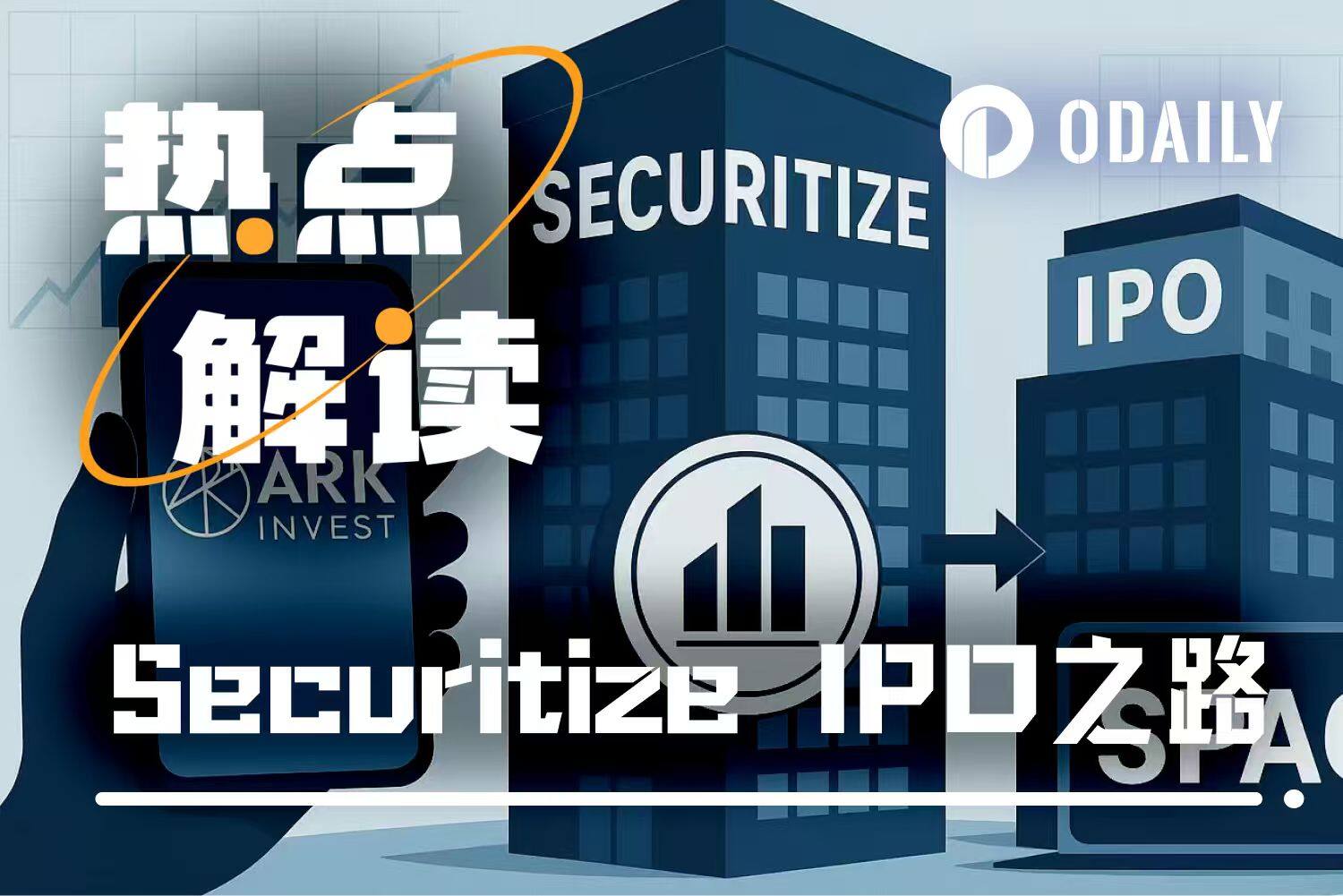การวิเคราะห์ข้อมูลแบบออนไลน์: Solana ซึ่งอยู่ในหล่มจะ "เอาตัวรอดจากความทุกข์ยาก" ได้หรือไม
เรียบเรียงข้อความต้นฉบับ: Bai Ze Research Institute
เรียบเรียงข้อความต้นฉบับ: Bai Ze Research Institute
ไม่ต้องสงสัยเลยว่าความเชื่อมั่นของนักลงทุนที่มีต่อ Solana...
ตรวจสอบรายการราคาด้านล่าง ในช่วง 14 เดือนที่ผ่านมา ราคาของ SOL (โทเค็นดั้งเดิมของ Solana) ได้ลดลงจากประมาณ 260 ดอลลาร์เหลือต่ำกว่า 10 ดอลลาร์ และในขณะที่เขียนนี้อยู่ที่ 16 ดอลลาร์เท่านั้น

ที่กล่าวว่า SOL ลดลงเกือบ 97% จากระดับสูงสุดตลอดกาล
ยิ่งไปกว่านั้น DeGods ซึ่งเป็นหนึ่งในโครงการ NFT อันดับต้น ๆ บน Solana เพิ่งประกาศว่าจะย้ายไปที่ Ethereum และโครงการที่สองของทีม Y 00 ts ก็จะย้ายไปที่ Polygon ด้วย
แน่นอนว่าทั้งหมดนี้เกิดขึ้นในขณะที่หนึ่งในผู้ถือ SOL รายใหญ่ที่สุด (มากกว่า 10% ของอุปทานทั้งหมด) และนักลงทุนในระบบนิเวศของ Solana FTX ล้มละลาย
ไม่ต้องสงสัยเลยว่าสิ่งต่าง ๆ กำลังมองหาสิ่งที่เลวร้ายสำหรับ Solana ในตอนนี้
อย่างไรก็ตาม ในปี 2018 นักลงทุน cryptocurrency ทราบดีว่า Ethereum เคยประสบกับสิ่งที่คล้ายกัน
ในปี 2018 ราคาของ ETH ลดลงเกือบ 94% จากระดับสูงสุดตลอดกาลที่ $1,428 เป็นประมาณ $85

cryptocurrency และพื้นที่ Web3 ในตอนนั้นแตกต่างจากตอนนี้อย่างมาก และหลังจากที่ตลาดหมีได้รับผลกระทบ เงินหลายโครงการหมดลงและนักลงทุนหนีออกจากพื้นที่ ซึ่งทำให้หลายคนแม้แต่สมาชิกที่ภักดีของชุมชน Ethereum ยังสงสัยใน Ethereum บล็อกเชนจะสำเร็จหรือไม่
โชคดีที่ในที่สุดชุมชน Ethereum ก็รอดชีวิตจากฤดูหนาวที่ยาวนานของการเข้ารหัสลับและกลายเป็นระบบนิเวศ Ethereum ที่มีชีวิตชีวาและเฟื่องฟูอย่างที่เรารู้จักในปัจจุบัน
หากมีสิ่งหนึ่งที่ฉันได้เรียนรู้จากความผิดพลาดของ ETH ในปี 2018 ก็คงจะเป็นความแตกต่างอย่างมากระหว่าง Ethereum blockchain และสกุลเงินพื้นเมือง ETH
เช่นเดียวกันกับ Solana blockchain และ SOL สกุลเงินท้องถิ่น ดังนั้น แม้ว่าราคาของ SOL จะดูค่อนข้างแย่ แต่ก็อาจไม่สะท้อนถึงสิ่งที่เกิดขึ้นบนบล็อกเชนของ Solana และชุมชนของมัน
ลองดูกราฟราคาของหุ้น Amazon ด้านล่าง
ในปี 2000 ราคาของ AMZN ลดลง 94.79% เป็น 4 ดอลลาร์ สถิติสูงสุดตลอดกาลล่าสุดของ AMZN ที่ 165 ดอลลาร์ในรอบ 26 ปีของการซื้อขายในตลาดหุ้น ได้เห็น:
เซเว่นลดราคามากกว่า 30%
สี่ราคาลดลงมากกว่า 50%
และสามราคาลดลงมากกว่า 60%
อย่างไรก็ตาม สิ่งนี้ไม่ได้ขัดขวางไม่ให้ Amazon เป็นหนึ่งในบริษัทที่ใหญ่ที่สุดในโลกในขณะนี้

ประเด็นคือราคาไม่เกี่ยวข้องกับเทคโนโลยีพื้นฐาน ราคาของเทคโนโลยีจะผันผวนอยู่เสมอ และบางครั้งอาจ "แยก" ออกจากมูลค่าพื้นฐานของเทคโนโลยีได้อย่างมีนัยสำคัญ
ชื่อระดับแรก
เหตุใดเอฟเฟกต์เครือข่ายจึงมีความสำคัญ
เอฟเฟกต์เครือข่ายเป็นปรากฏการณ์ที่ผู้เข้าร่วมใช้เทคโนโลยีเฉพาะ (หรือโต้ตอบกับเทคโนโลยีนั้น) มากขึ้นเรื่อยๆ เพิ่ม "คุณค่า" ของเทคโนโลยีนั้น
เทคโนโลยีที่มีค่ามากขึ้นจะเพิ่มจำนวนนักแสดงที่ใช้ (หรือโต้ตอบกับ) เทคโนโลยี ซึ่งเพิ่ม "มูลค่า" ของมันอีกครั้ง ซึ่งเพิ่มจำนวนนักแสดง
ตัวอย่างเช่น อินเทอร์เน็ตเริ่มดีขึ้นเรื่อย ๆ เนื่องจากผู้คนเริ่มใช้อินเทอร์เน็ตมากขึ้นเรื่อยๆ Facebook, Amazon และอื่น ๆ มีข้อได้เปรียบด้านเครือข่ายเดียวกัน
เมื่อเทคโนโลยีเข้าถึงผลกระทบเครือข่ายในระดับหนึ่ง ก็ยากที่จะตาย โดยเฉพาะอย่างยิ่งหากเครือข่ายนั้นยังคงเติบโตต่อไปเมื่อเวลาผ่านไป ทั้ง Bitcoin และ Ethereum อาจมาถึงจุดนี้แล้ว
ดังนั้น เมื่อเราถามคำถามว่า "โซลานากำลังจะตายหรือไม่" สิ่งที่เราต้องทำคือดูที่ผลกระทบเครือข่ายของมัน เราต้องตรวจสอบว่าผู้เข้าร่วมของ Solana blockchain (เช่น ผู้ใช้และนักพัฒนาซอฟต์แวร์) กำลังทำอะไรอยู่
ความสวยงามของเทคโนโลยีบล็อกเชนคือเราสามารถทำได้!
เราสามารถดูแนวโน้มของผู้ใช้ใหม่ใน Solana blockchain
เราสามารถตรวจสอบแนวโน้มในการทำธุรกรรมของผู้ใช้และมูลค่าบน Solana blockchain
สิ่งที่สำคัญที่สุด (โดยเฉพาะอย่างยิ่งในช่วงแรก ๆ ของเทคโนโลยี) เราสามารถศึกษาแนวโน้มในกิจกรรมของนักพัฒนาและโครงการใหม่ ๆ ที่กำลังปรับใช้บนบล็อกเชน
ก่อนวิเคราะห์ข้อมูลบนเครือข่าย โปรดทราบว่าขณะนี้เราเข้าสู่ตลาดหมีเป็นเวลา 14 เดือน ดังนั้น ตัวเลขอาจดูแย่เป็นธรรมดา
กระเป๋าเงินที่ใช้งานอยู่
กระเป๋าเงินที่ใช้งานอยู่
หากเราดูที่ผู้ใช้งานรายวัน (DAU) บน Solana blockchain เราพบว่า DAU ลดลง 78.8% จากระดับสูงสุดตลอดกาลที่ 454,229 สู่ระดับต่ำสุดที่ 95,958 หลังเหตุการณ์ FTX
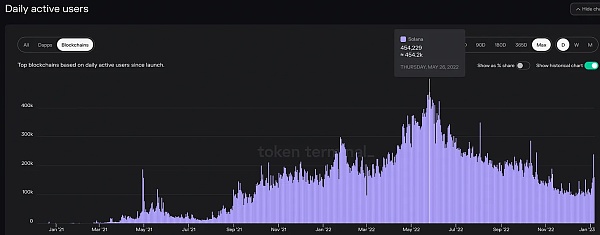
ในทางตรงกันข้าม Ethereum เห็นการลดลงของ DAU ที่น้อยกว่ามาก DAU ของ Ethereum ลดลงจาก 528,671 สู่ระดับต่ำสุดที่ 295,500 ซึ่งลดลง 44% ในช่วงเวลาเดียวกันบน Solana
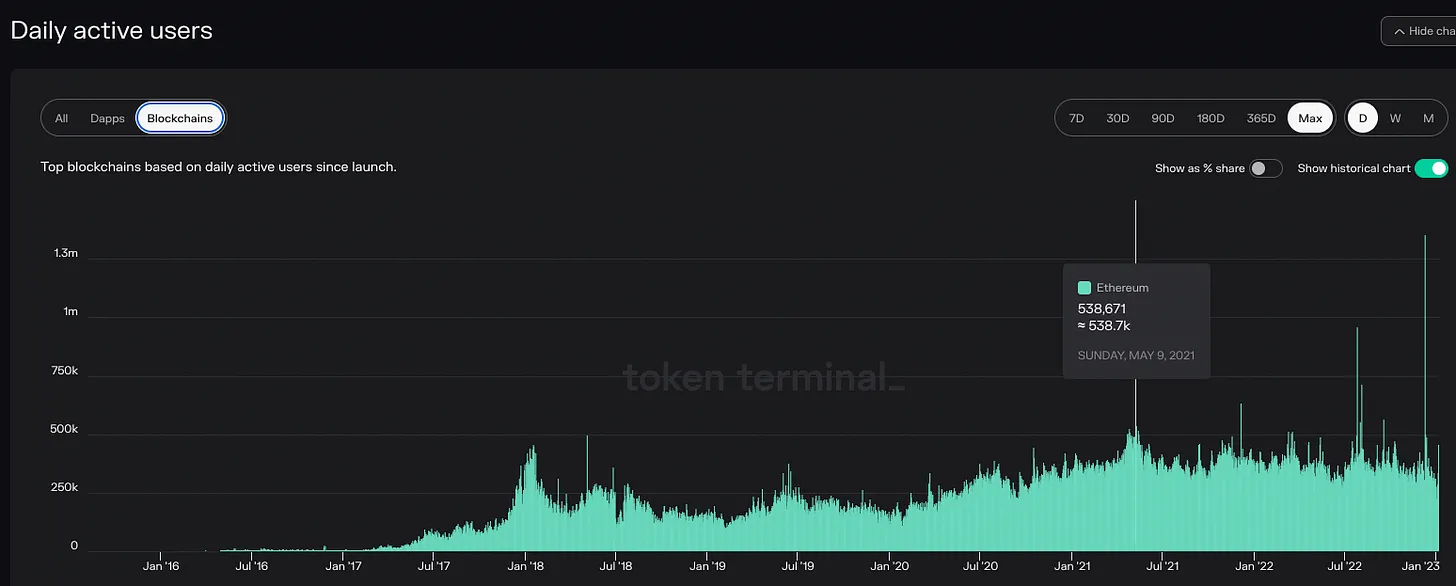
เราต้องจำไว้ว่าจุดสนใจของชุมชน Ethereum ในปัจจุบันคือการย้ายผู้ใช้จากเลเยอร์ 1 ไปยังเลเยอร์ 2 ที่เพิ่งเฟื่องฟู เช่น Arbitrum และ Optimism
เราสามารถเห็นได้จากกราฟด้านล่างว่า L2 เหล่านี้ได้รับผู้ใช้จริงในช่วง 14 เดือนของตลาดหมี
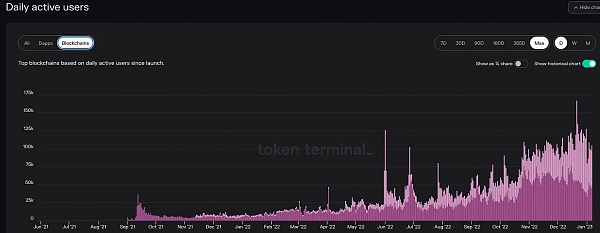
อย่างไรก็ตาม การเปรียบเทียบที่ยุติธรรมกว่านั้นอาจดูที่การลดลงของ Ethereum ใน DAU ระหว่างการพังทลายของ ETH ในปี 2018 ที่น่าสนใจคือในช่วงตลาดหมีปี 2018 Ethereum DAU ลดลงจาก 459,969 เป็น 128,265 ซึ่งลดลง 72% ใน DAU
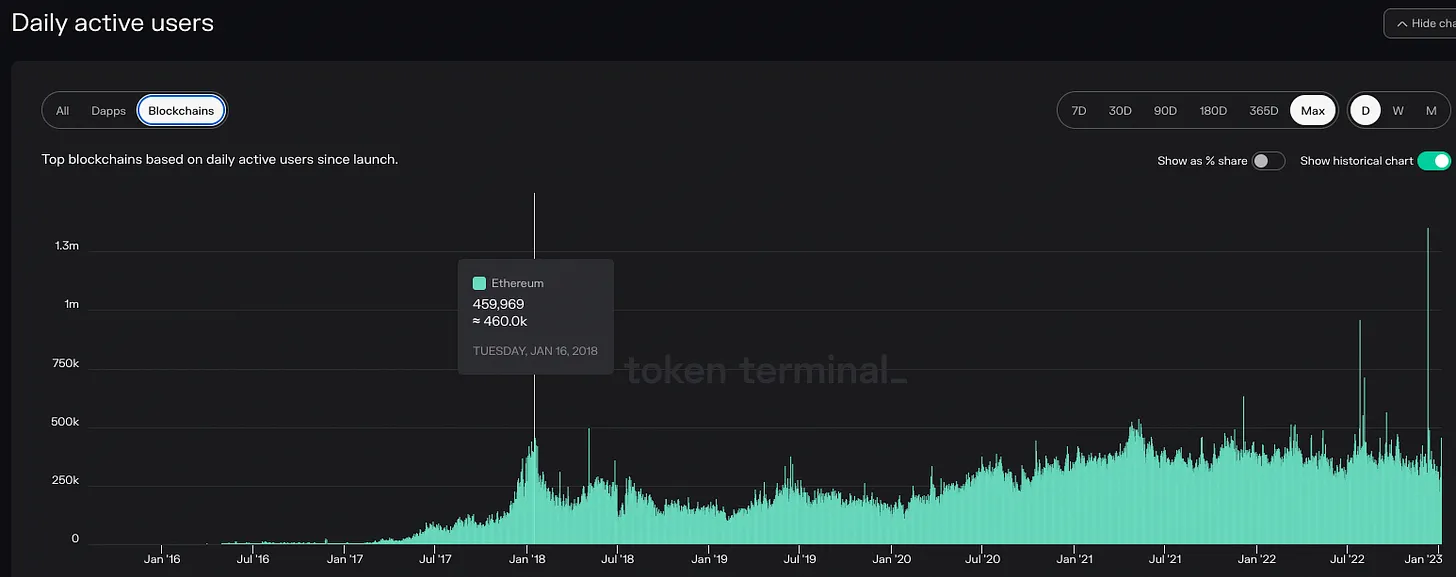
สรุป...
ผู้ใช้งานรายวัน
Solana 2022 = -78.8%
อีเธอเรียม 2022 = -44%
ราคา
ราคา
Solana 2022 = -97%
อีเธอเรียม 2022 = -79%
อีเธอเรียม 2018 = -94%
จนถึงตอนนี้ในตลาดหมี Solana ดูเหมือนว่าจะทำงานคล้ายกับ Ethereum ในปี 2018 ในแง่ของราคาและ DAU
ข้อแตกต่างที่สำคัญคือ Solana เผชิญกับการแข่งขันโดยตรงจากเครือข่ายสาธารณะอื่น ๆ ในตลาดหมี ในขณะที่ในปี 2018 Ethereum เป็นแพลตฟอร์มสัญญาอัจฉริยะเพียงแพลตฟอร์มเดียวและใช้งานได้จริง
เป็นที่น่าสังเกตว่า Ethereum L1 และ Solana blockchains ไม่ควรถูกมองว่าเป็นคู่แข่งกัน เนื่องจากเป้าหมายของพวกเขาแตกต่างกันมาก อย่างไรก็ตาม Ethereum L2 และ Polygon เป็นคู่แข่งโดยตรงของ Solana
ชื่อระดับแรก
การทำธุรกรรมและ TVL
Solana ทำธุรกรรม (txns) ต่อสัปดาห์มากกว่า Ethereum อย่างมีนัยสำคัญ
อย่างไรก็ตาม ความถูกต้องตามกฎหมายของ txns เหล่านี้ยังเป็นที่น่าสงสัย เนื่องจากเชื่อว่า txns จำนวนมากบน Solana เป็นบอทที่ทำธุรกรรมเป็นชุด
Solana เห็นธุรกรรมรายสัปดาห์ลดลง 74% จาก 496,847,478 เป็น 127,963,178 และ Ethereum ลดลง 40% จาก 11,074,661 เป็น 6,705,093 ในช่วงเวลาเดียวกัน (กราฟนี้ใช้สำหรับอ้างอิงเท่านั้น และไม่รวมธุรกรรมการลงคะแนนเสียงทั้งหมดบน Solana)
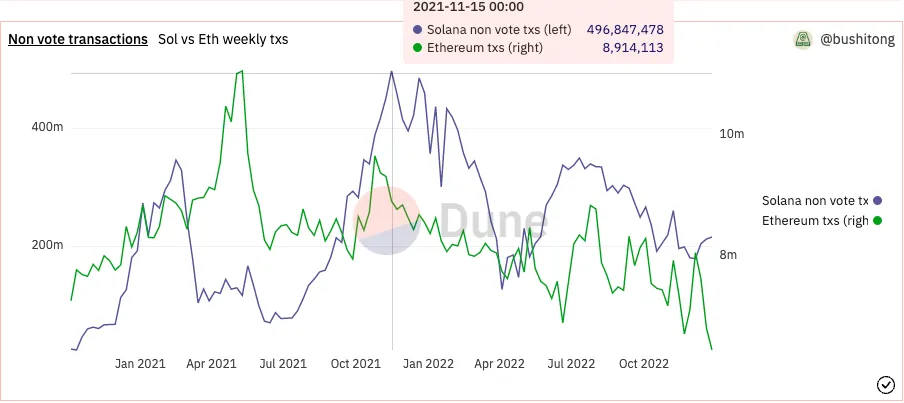
ลองย้อนกลับไปดูประวัติศาสตร์และดูว่า Ethereum ซื้อขายอย่างไรในช่วงตลาดหมีปี 2018 เราจะเห็นว่าปริมาณธุรกรรมรายสัปดาห์ของ Ethereum ลดลง 64% จาก 8,203,034 ธุรกรรมเป็น 2,959,182 ธุรกรรม

สรุป...
ข้อตกลงรายสัปดาห์
Solana 2022 = -74%
อีเธอเรียม 2022 = -40%
อีเธอเรียม 2018 = -64%
ในทำนองเดียวกัน Solana และ Ethereum ก็มีสถิติที่คล้ายคลึงกันในปี 2018
นอกจากธุรกรรมแล้ว เรายังสามารถดูมูลค่ารวมของเงินที่ถูกล็อคในบล็อกเชนใดๆ และการเปลี่ยนแปลงเมื่อเวลาผ่านไป TVL ของ Solana ลดลง 98% จาก 10.17 พันล้านดอลลาร์เป็น 230 ล้านดอลลาร์
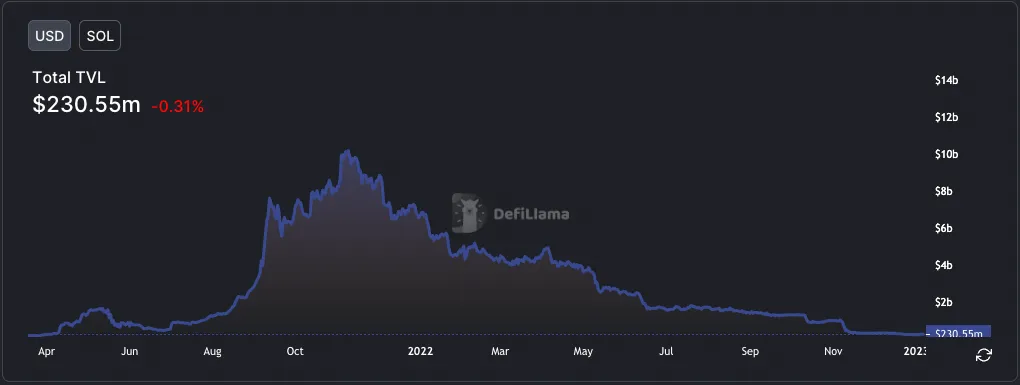
TVL ของ Ethereum ลดลง 78% จาก 109.49 พันล้านดอลลาร์เป็น 23.82 พันล้านดอลลาร์
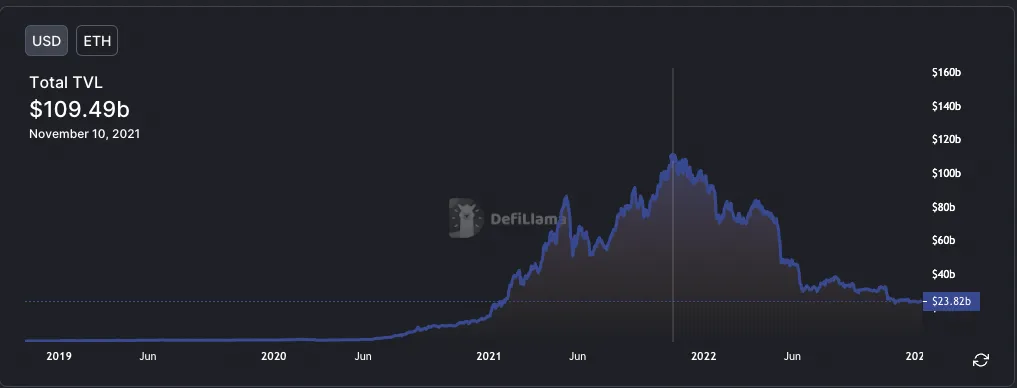
ชื่อระดับแรก
กิจกรรมของนักพัฒนาและการปรับใช้
คล้ายกับการทำธุรกรรม เราควรนำหมายเลขกิจกรรมของนักพัฒนาซอฟต์แวร์ไปด้วยเม็ดเกลือ
นี่เป็นเมตริกที่ติดตามได้ยาก โดยเฉพาะในระบบนิเวศ Ethereum เนื่องจากมีไคลเอ็นต์ Ethereum ที่แตกต่างกันมากมาย นอกจากนี้ หลายทีมกำลังสร้างเฉพาะใน L2 ไม่ใช่ Ethereum
ในแผนภูมิด้านล่าง เราใช้การติดตามของ Token Terminal ของ Github สำหรับแต่ละบล็อกเชน และเป็นที่ชัดเจนว่าตัวเลขเหล่านั้นไม่ถูกต้อง ดังนั้น เรามาเน้นที่จำนวนจริงให้น้อยลงและเน้นที่เปอร์เซ็นต์การเปลี่ยนแปลงให้มากขึ้น
นักพัฒนาที่ใช้งานรายวันของ Solana อยู่ในช่วงจากสูงสุด 156 ถึงต่ำสุดที่ 61 ลดลง 61% Ethereum เพิ่งมีจุดสูงสุดที่ 296 และต่ำสุดที่ 153 ลดลง 48%
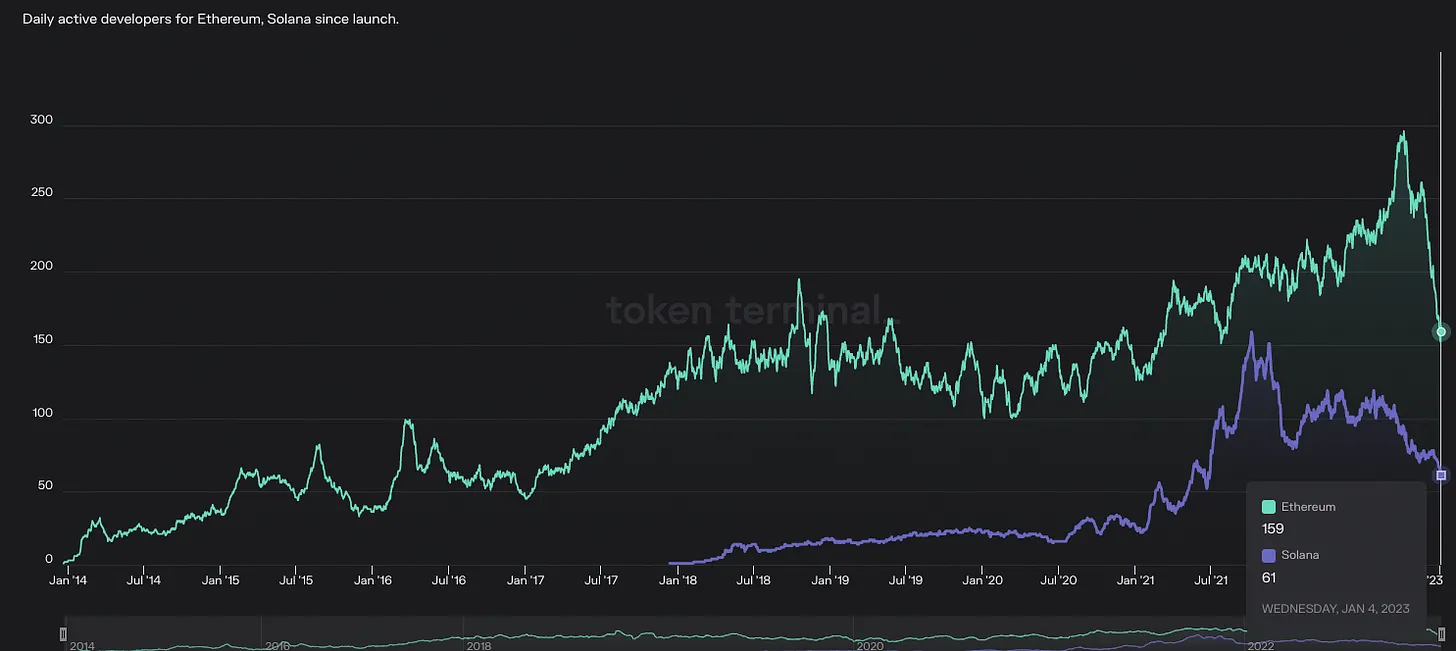
แต่อีกครั้ง เราควรพิจารณาการเติบโตของนักพัฒนาของระบบนิเวศ Ethereum ทั้งหมด เนื่องจากนักพัฒนาและทีม Ethereum จำนวนมากกำลังเปลี่ยนไปใช้ Ethereum L2 ต่างๆ ที่เร็วและถูกกว่า
นี่คือเหตุผลที่การเติบโตของจำนวนนักพัฒนา Arbitrum, Optimism, Starknet และ Polygon ในช่วงที่ผ่านมาไม่ควรเพิกเฉย
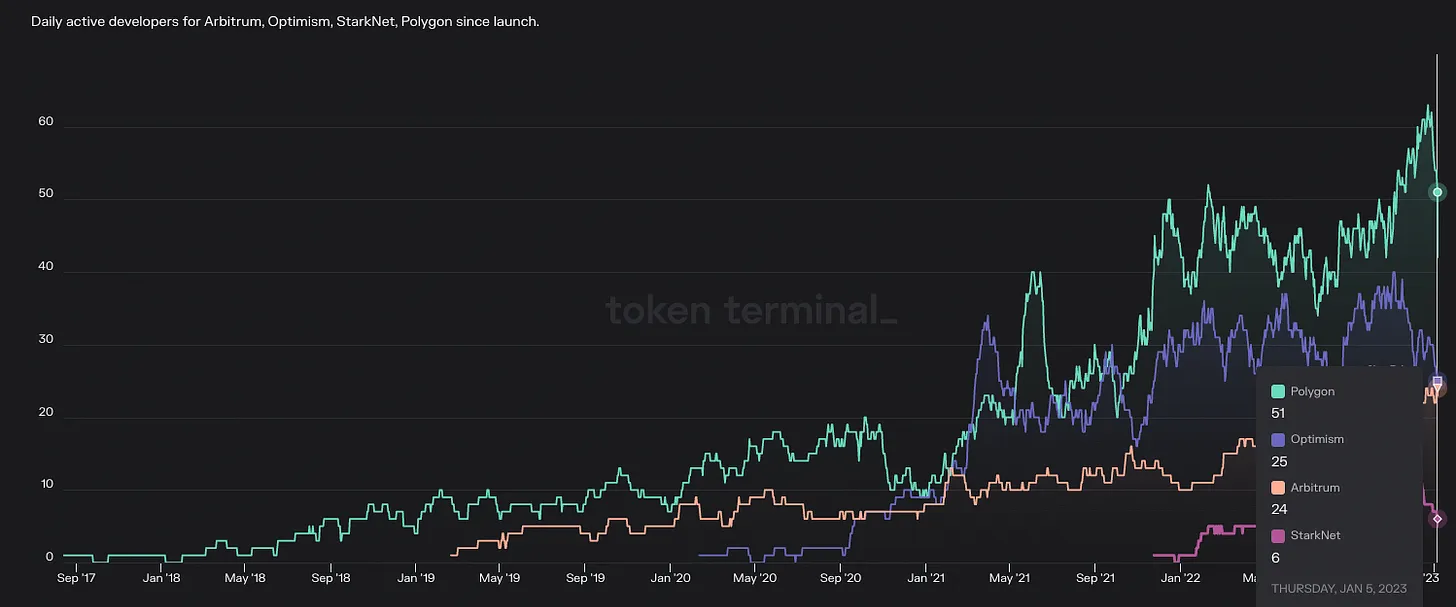
แต่อีกครั้ง มาดูข้อมูลย้อนหลังของ Ethereum ในปี 2018 ในขณะนั้น นักพัฒนาที่ใช้งานประจำวันของ Ethereum ลดลง 49% จาก 195 เป็น 100

สรุป...
นักพัฒนาที่ใช้งานรายวัน:
Solana 2022 = -61%
อีเธอเรียม 2022 = -48%
อีเธอเรียม 2018 = -49%
นี่เป็นตัวบ่งชี้แรกในบทความนี้จนถึงตอนนี้ที่ Solana ไม่ได้เลียนแบบ Ethereum ในปี 2018 ฉันคิดว่าเหตุผลกลับไปที่การแข่งขัน
ในปี 2018 หากนักพัฒนาต้องการพัฒนาบนแพลตฟอร์มสัญญาอัจฉริยะอื่นที่ไม่ใช่ Ethereum พวกเขาไม่มีที่ไป วันนี้มีมากกว่า 20 L1s และ 20+ L2s ที่นักพัฒนาสามารถเลือกได้
ดังที่ได้กล่าวไว้ในตอนต้น เราได้เห็นโครงการที่มีชื่อเสียงจาก Solana ย้ายไปที่ Ethereum และ Polygon ในช่วงไม่กี่สัปดาห์ที่ผ่านมา ดังนั้นจึงเป็นเรื่องน่าสนใจที่จะดูว่าแนวโน้มนี้จะดำเนินต่อไปตลอดปี 2566 หรือไม่
สำหรับการเปรียบเทียบสองสามรายการล่าสุด เราจะตรวจสอบแนวโน้มของโทเค็นที่ใช้ร่วมกันได้ (FT) และโทเค็นที่ไม่สามารถใช้ร่วมกันได้ (NFT) ที่เพิ่งสร้างใหม่ในระบบนิเวศทั้งสอง
อันที่จริง ฉันค่อนข้างจะเปรียบเทียบจำนวนรวมของการปรับใช้สัญญาอัจฉริยะในระบบนิเวศทั้งสอง เนื่องจากนักพัฒนาซอฟต์แวร์กำลังสร้างมากกว่าแค่โทเค็นบนบล็อกเชน อย่างไรก็ตาม ฉันไม่พบข้อมูลการปรับใช้สัญญาอัจฉริยะของ Solana
ในกราฟด้านล่าง เราจะเห็นว่า Solana มีจุดสูงสุดในไตรมาสที่ 3 ปี 2022 โดยมีการติดตั้ง FT ใหม่ 1,000 ถึง 1,500 รายการต่อวัน และลดลงเหลือประมาณ 300-800 รายการหลังจากนั้น
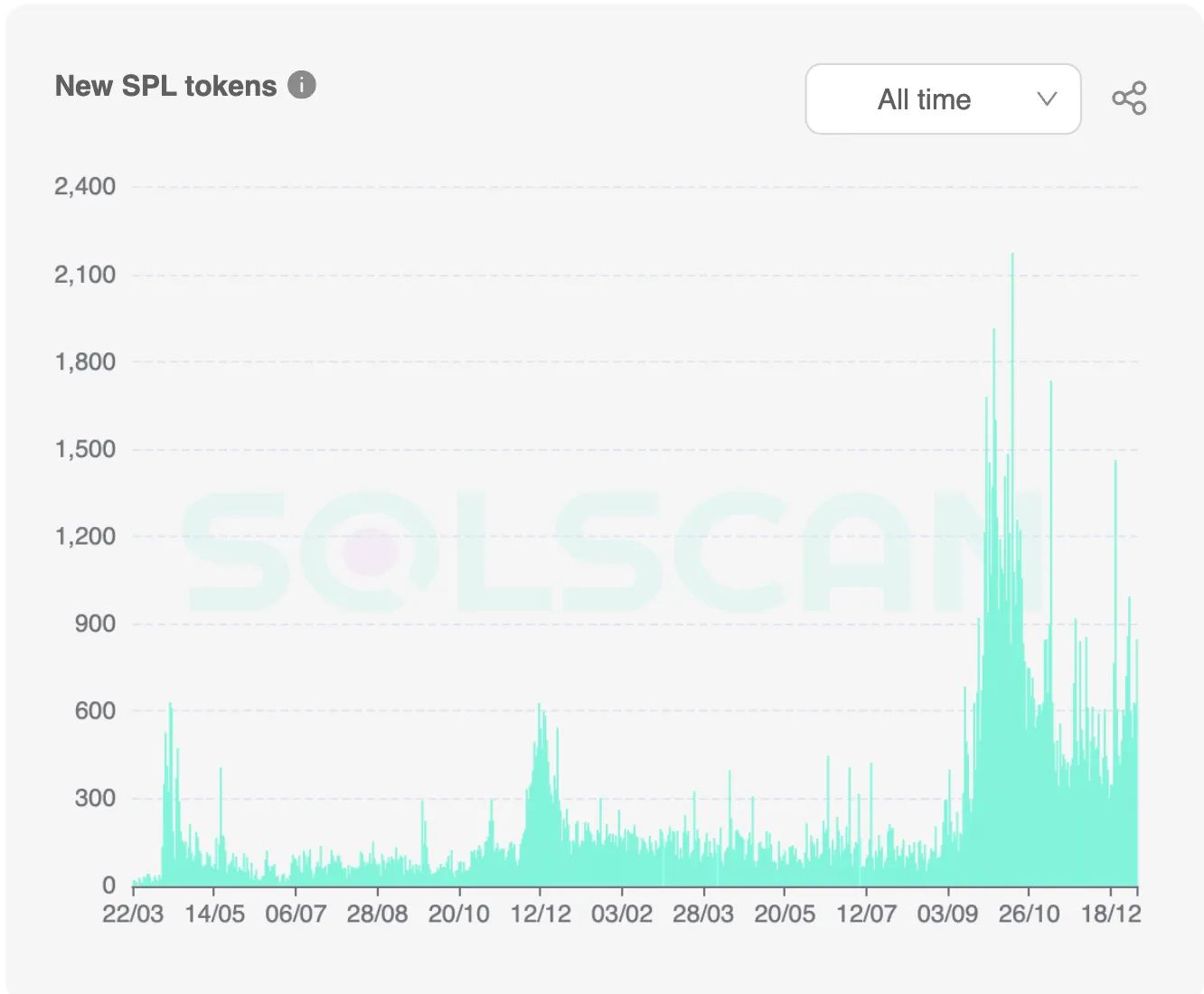
นอกเหนือจากการเพิ่มขึ้นเล็กน้อยในเดือนตุลาคม การปรับใช้ FT ของ Ethereum ยังคงแข็งแกร่งระหว่าง 500 ถึง 1,000 ในช่วงไม่กี่เดือนที่ผ่านมา

เมื่อพิจารณาจาก NFT แล้ว Solana ได้รับความนิยมอย่างเห็นได้ชัดตั้งแต่เดือนตุลาคม ก่อนหน้านี้มีการสร้าง NFT เฉลี่ยประมาณ 100,000 รายการต่อวัน แต่ตอนนี้เฉลี่ยเพียง 25,000 รายการต่อวัน ซึ่งต่ำกว่าจุดสูงสุดก่อนเดือนตุลาคม
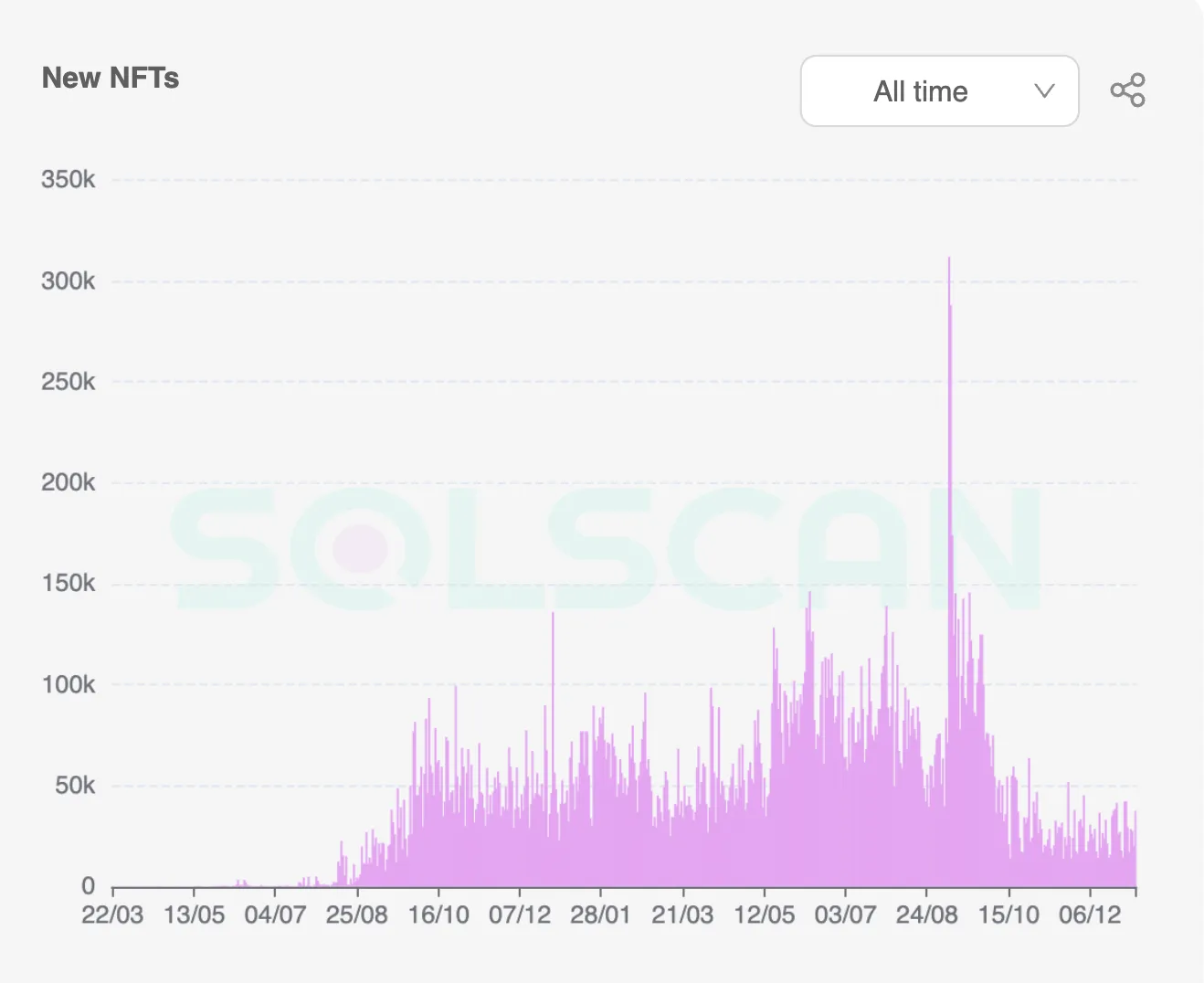
ข้อมูลสำหรับ Ethereum นั้นแตกต่างออกไปเล็กน้อย เนื่องจากแผนภูมินี้แสดงจำนวนของ NFT smart contracts ไม่ใช่จำนวนของ NFT ที่สร้างเสร็จ ที่กล่าวว่า Ethereum กลับสู่ระดับสูงสุดก่อนเดือนตุลาคมอีกครั้ง
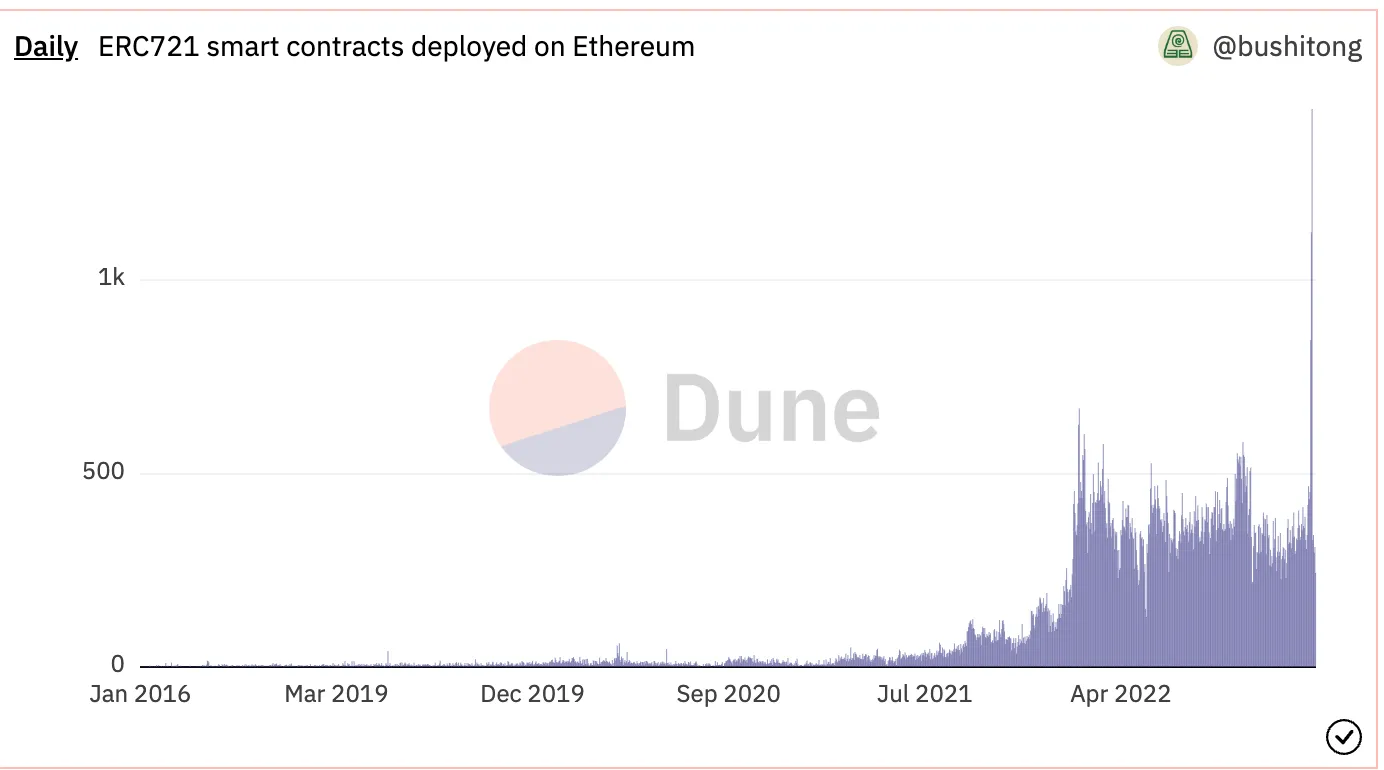
ชื่อระดับแรก
Solana ตายแล้ว / กำลังจะตายในไม่ช้า?
หากเราดูเฉพาะเมตริกบนเครือข่าย ไม่มีอะไรบ่งบอกว่า Solana นั้นตายแล้ว
บางคนอาจโต้แย้งว่าสถิติเหล่านี้แสดงให้เห็นว่า Solana กำลัง "กำลังจะตาย" อย่างไรก็ตาม ตัวเลขเหล่านี้สำหรับ Solana มีความคล้ายคลึงกับ Ethereum ในปี 2018 ซึ่งสามารถอยู่รอดและเติบโตได้ในตลาดหมี 2 ปี
ฉันไม่เข้าใจว่าทำไม Solana ถึงทำสิ่งนี้ไม่ได้ นอกจากจะมีทีมผู้นำที่มีพรสวรรค์อย่างเหลือเชื่อแล้ว พวกเขายังดูเหมือนจะมีชุมชนที่เข้มแข็งอีกด้วย
อย่างไรก็ตาม ความแตกต่างที่ใหญ่ที่สุดระหว่าง Solana ในวันนี้กับ Ethereum ในปี 2018 ก็คือ Solana เผชิญกับการแข่งขันที่ดุเดือด
Solana พยายามที่จะเป็นราชาแห่งบล็อกเชน "ผู้บริโภค" ซึ่งเป็นบล็อกเชนที่รวดเร็ว ราคาถูก และเป็นมิตรกับมือถือสำหรับคนทั่วไป
Ethereum ไม่เข้าร่วมการต่อสู้เพราะนั่นไม่ใช่เป้าหมาย Ethereum มีเป้าหมายที่จะเป็นชั้นฉันทามติที่มีการกระจายอำนาจและปลอดภัยสูงสุดสำหรับอินเทอร์เน็ต
ที่กล่าวว่า ระบบนิเวศของ Ethereum ได้เปิดตัวคู่แข่งบางรายกับ Solana แล้ว เช่น Polygon, Optimistic L2 หลายตัว (Arbitrum และ Optimism) และ ZK L2 เช่น Immutable โดยมี L2 อีกจำนวนมากกำลังเข้าร่วมการต่อสู้
บนพื้นฐานของ Ethereum แต่ละ L2s เหล่านี้มีความสามารถในการทำธุรกรรมที่รวดเร็วและราคาถูก ในขณะที่ยังคงกระจายอำนาจและปลอดภัย
แม้ว่าเทคโนโลยีของ Solana จะมีศักยภาพที่เหนือกว่าในด้านความสามารถในการปรับขนาด แต่เรายังไม่ได้เห็นการใช้งานจริง
การถกเถียงเกี่ยวกับอนาคตของมัลติเชนและคุณสมบัติที่บล็อกเชนต้องการนั้นอยู่นอกเหนือขอบเขตของบทความนี้
แต่สิ่งที่ฉันจะพูดก็คือมีความต้องการบล็อกเชนจำนวนมากในโลกกระแสหลัก และมันจะเติบโตขึ้นเมื่อเวลาผ่านไป ในขณะที่การแข่งขันระหว่างบล็อกเชนกำลังร้อนระอุ เรายังไม่มีบล็อกเชนที่ใช้งานได้ดีพอที่จะรองรับการยอมรับจำนวนมากในโลกกระแสหลักในระยะสั้นถึงกลาง
มีพื้นที่มากมายสำหรับ Solana, ระบบนิเวศ Ethereum และบล็อกเชนอื่น ๆ ที่จะเติบโตไปด้วยกันแทนที่จะแข่งขันกันเพื่อแย่งชิงส่วนแบ่งการตลาด
ตาม "ประกาศเกี่ยวกับการป้องกันและจัดการกับความเสี่ยงในการทำธุรกรรมสกุลเงินเสมือนเพิ่มเติม" ที่ออกโดยธนาคารกลางและหน่วยงานอื่น ๆ เนื้อหาของบทความนี้มีไว้สำหรับการแบ่งปันข้อมูลเท่านั้น และไม่ส่งเสริมหรือสนับสนุนการดำเนินการและการลงทุนใด ๆ พฤติกรรม เข้าร่วมในการปฏิบัติทางการเงินที่ผิดกฎหมาย
คำเตือนความเสี่ยง:
ตาม "ประกาศเกี่ยวกับการป้องกันและจัดการกับความเสี่ยงในการทำธุรกรรมสกุลเงินเสมือนเพิ่มเติม" ที่ออกโดยธนาคารกลางและหน่วยงานอื่น ๆ เนื้อหาของบทความนี้มีไว้สำหรับการแบ่งปันข้อมูลเท่านั้น และไม่ส่งเสริมหรือสนับสนุนการดำเนินการและการลงทุนใด ๆ พฤติกรรม เข้าร่วมในการปฏิบัติทางการเงินที่ผิดกฎหมาย


